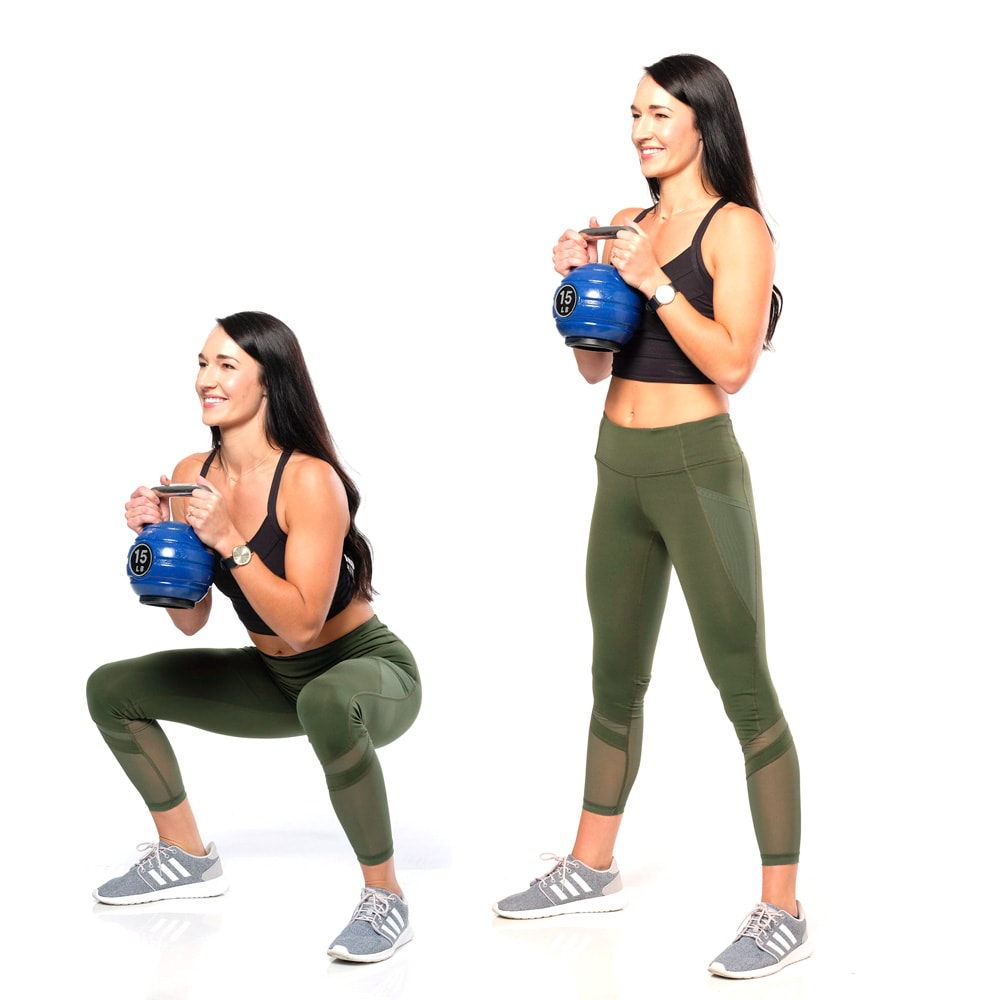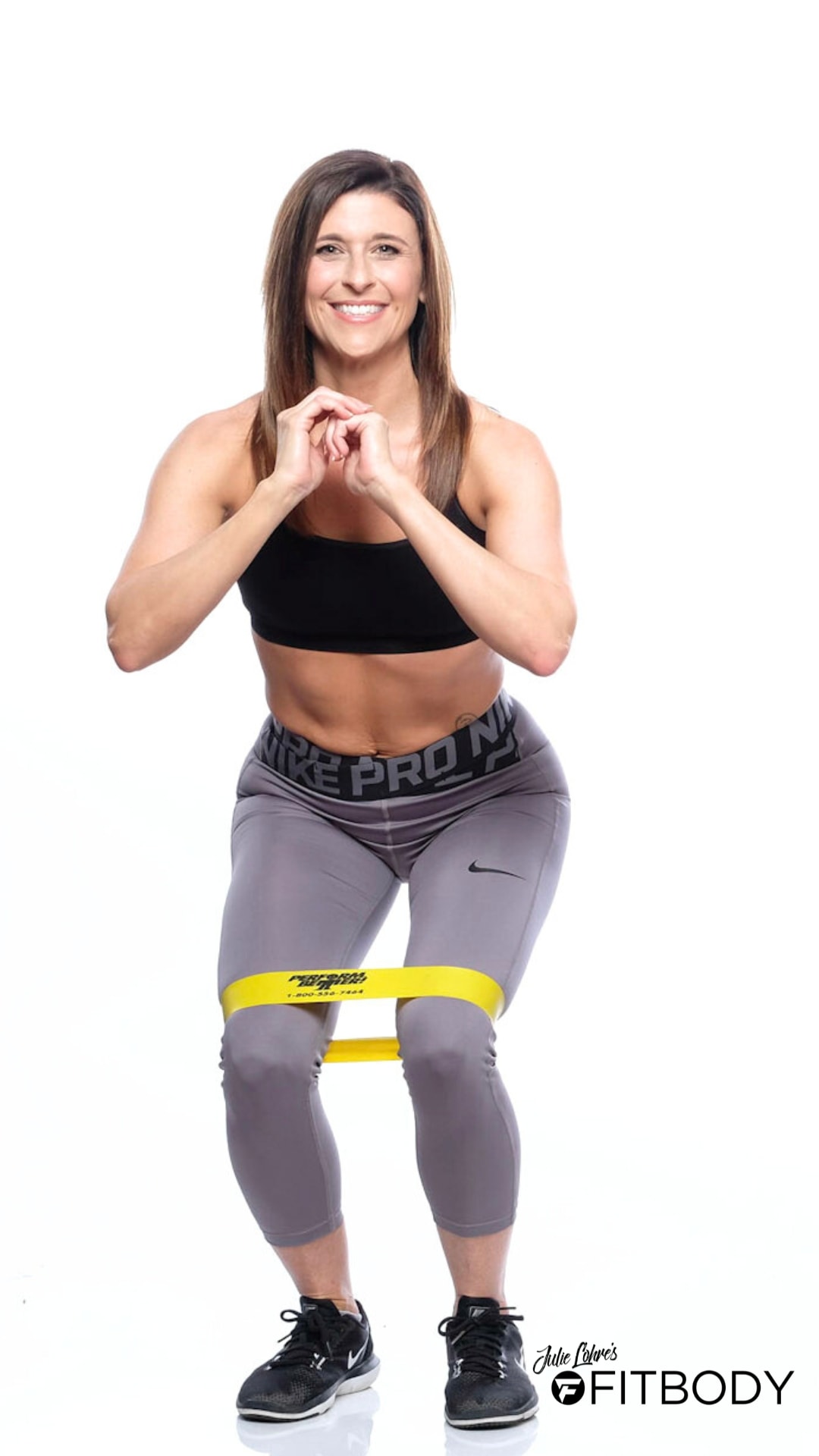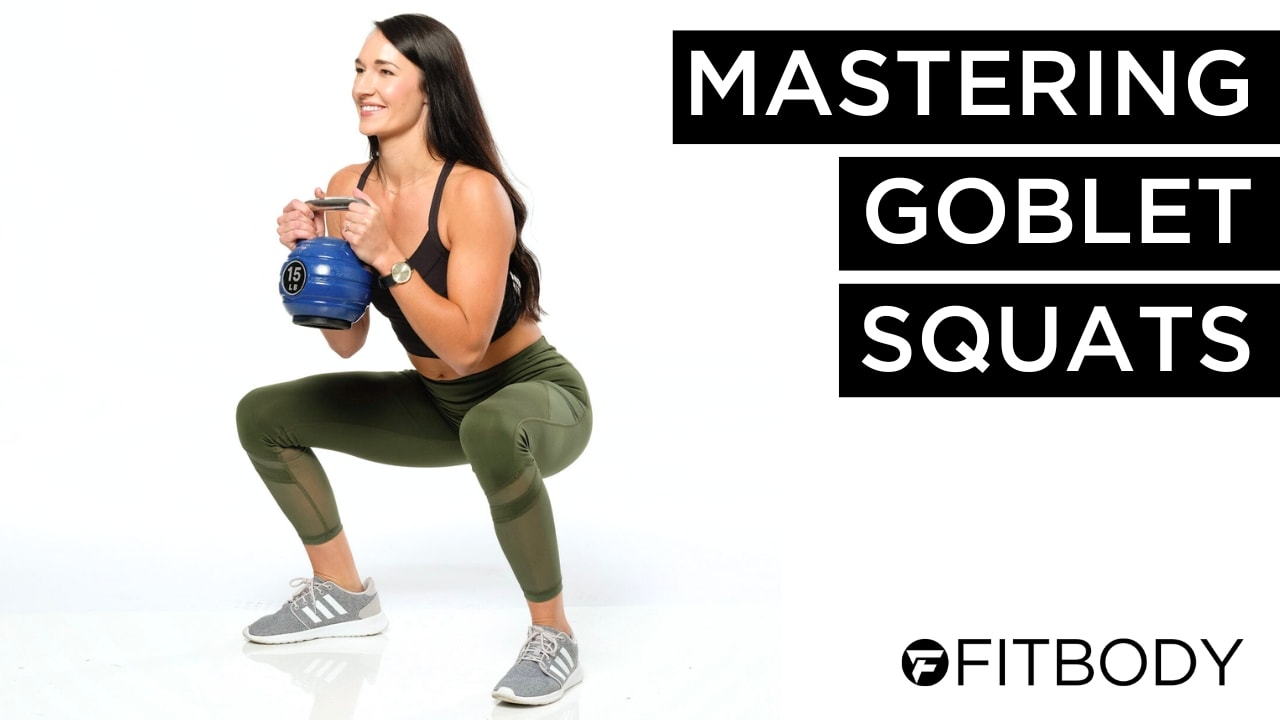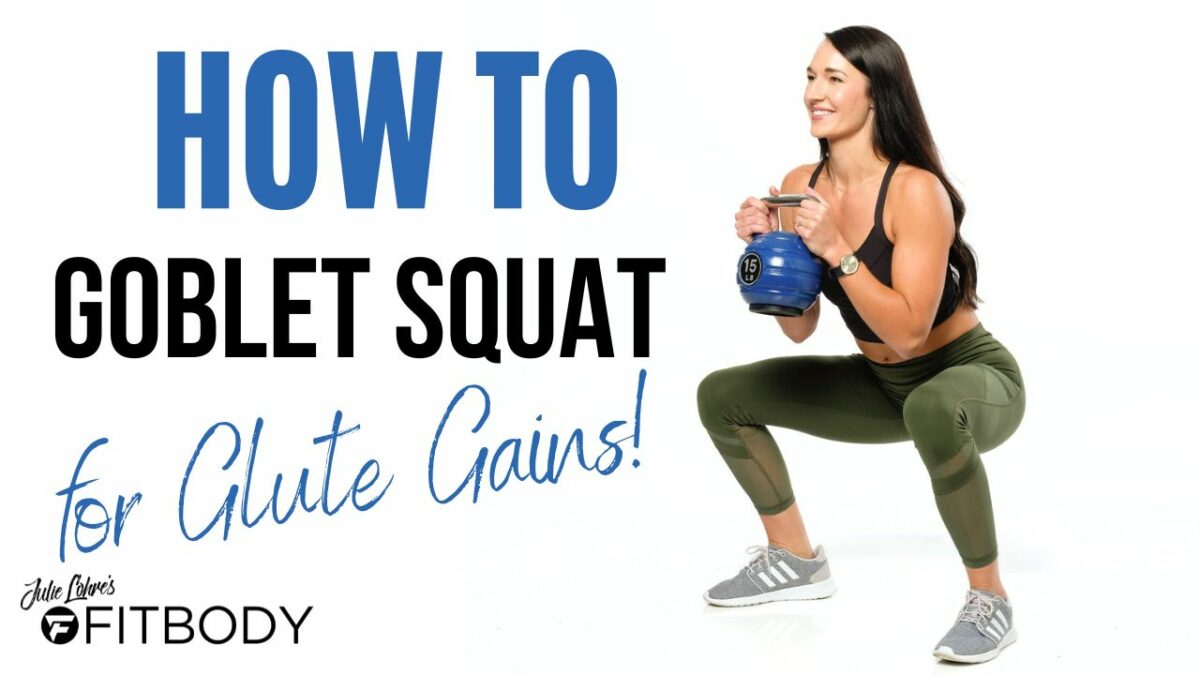Mastering the Goblet Squat: A Comprehensive Guide for Optimal Results

The Goblet Squat is a lower-body exercise in which you hold a dumbbell or kettlebell with both hands in front of your chest. Welcome, to your ultimate guide on mastering this do-anywhere squat! Perfect for women that workout at home, this is an exercise that I frequently recommend for my Online Fitness Coaching clients that are looking to strengthen the lower body, improve overall fitness, and build lean and shapely glutes. For most women in fact, this squat variation is a must-try lower body movement! Don’t worry if you’re a beginner; I’ve got you covered with step-by-step instructions and key points to focus on. Let’s dive right in!
The Benefits of Goblet Squat: Strengthen Your Lower Body
Before I get into the nitty-gritty, let’s talk about why the goblet squat deserves a place in your fitness routine. This compound exercise targets multiple muscle groups simultaneously, primarily engaging your quadriceps, hamstrings, glutes, and core. The result? Stronger legs, improved balance, and enhanced functional movement.
One of my favorite things about goblet squats is that they enhance your posture, as they encourage better alignment of the spine. For a women that sits in front of the computer for work, this is crucial. Plus, they’re a great calorie-burner, helping you on your journey to a FitBody.
How to Perform the Goblet Squat: Step-by-Step Guide
- Stand Tall: Stand with your feet shoulder-width apart and your toes slightly turned out. To begin hold a dumbbell or kettlebell close to your chest with both hands. I like to hold the weight against my body so it’s touching my sternum and stomach.
- Initiate the Squat: Brace your core, keep your chest up, and start the squat by pushing your hips back. Imagine sitting down on an imaginary chair.
- Reach the Depth: Lower yourself until your thighs are at least parallel to the ground. Keep your knees tracking in line with your toes and maintain a neutral spine throughout the movement. I find it best to keep the weight in contact with your body and to continue until your elbows touch your knees.
- Rise Up: Push through your heels and engage your glutes and quads as you return to a standing position.Breathe out, exhaling as you push through the squat and stand up. At the top of the movement, slightly roll you hips under slightly as you contract your glutes to really engage the butt and your posterior chain.
- Repeat and Breathe: Repeat for the desired number of reps while maintaining controlled breathing throughout the exercise.

Goblet Squat Form & Mistakes: Key Points to Focus On
As a strength coach and online personal trainer with more than 15 year experience helping women worldwide get the butt and glutes of their dreams, I know a thing or two about exercise form.The Goblet Squat is fairly mistake-proof, which is one thing that makes it such a great exercise. However, there are some common mistakes you need to avoid to perform the move with perfect form.
Goblet Squat Mistake 1: Your torso tilts forward
Often times women allow their toro to tilt forward allowing their chest and the weight to come out over their knees. This can place undue strain on the lower back and take the focus of the exercise off the butt, hence losing that glute activation we are after. If you find yourself leaning forward too much, that is an indication that your ankles are too tight or your core isn’t strong enough. You can tell if you tilt too far forward if the bottom portion of the kettlebell comes off your stomach or rib cage.
The Fix: There are two quick fixes. First, consciously tighten your core and keep the dumbbell in contact with your stomach throughout the rep. Second, place a 5- or 10-pound plate under your heels to overcome any ankle mobility problem. If those do not help, you may be trying to lift too much weight. Decrease the weight you are using and try again.
Goblet Squat Mistake 2: Your knees collapse inward
One of the worst mistakes I see women make during a Squat is to allow their knees to collapse inward. Technically called valgus collapse, this technique flaw puts your knees at risk during the exercise. Worse, there’s a good chance your knees also do this in dynamic movements in your sport, such as when you land from a jump, when you’re more susceptible to an injury.
The Fix: Wrap a lightweight mini-band around your shins just below your knees. The tension from the band engages your glutes and teaches you to push your knees outward so they’re in line with your hips and ankles.

Which is better, a Goblet Squat, Back Squat, or Front Squat?
The Goblet Squat develops lower-body strength, size and power similar to other versions of the Squat. While I would not say that the goblet squat is better than the other variations of squats, it does have a few unique benefits compared to the Back Squat and Front Squat.
Goblet Squats Teaches Proper Squat Form
The Goblet Squat is the perfect option for an athlete learning how to squat. Someone who has little experience in the weight room can be confident they’re squatting with at least decent form if they can keep the weight in contact with their sternum and stomach, and their elbows touch their knees.
If not, the fixes are relatively easy, as described above. Watching the progress women can make in their overall squat form when completing Goblet Squats is almost like magic! Often it removes fear of having a barbell on your back that if you fail in your form or fall back due to putting weight in your heels.
It’s Easier on Your Back and Neck
If Back Squats are uncomfortable across your neck or you experience back pain with weighted barbell squats, then Goblet Squats are a great option. The goblet position shifts the load to the front of your core and allows for a more upright torso position, which is easier on the spine. In fact, goblet squats can be considered a weighted core exercise, because your abs, obliques and other core muscles have to engage to perform the exercise properly.
Goblet Squats Can Be Loaded Heavy
Many athletes and coaches make the mistake of categorizing Goblet Squats as a beginner exercise and only do them with light weight. I definitely think the are a great teaching leg and glute exercise but that doesn’t mean you can’t go heavy. You will ultimately be limited by how heavy the dumbbells or kettlebells are in your gym, but feel free to load up on the weight and challenge yourself. Even strong athletes who regularly Back Squat hundreds of pounds can benefit from heavy Goblet Squats.
Variations of the Goblet Squat: Challenge Yourself
Once you’ve mastered the basic goblet squat, it’s time to level up! Here are some variations to add excitement and challenge to your routine:
Advanced Goblet Squat: Adding Resistance
Increase the intensity of your goblet squats by using a heavier dumbbell or kettlebell. Remember to maintain proper form and gradually increase the weight to avoid strain.
Goblet Squat with a Twist: Rotational Variations
Incorporate rotation into your goblet squat to engage your obliques and improve core stability. Hold the weight at your chest and twist your torso to one side as you descend into the squat. Alternate sides for a well-rounded workout.

Goblet Squat Muscles Worked
Goblet squats are a highly effective compound exercise that targets several major muscle groups in your lower body and core. When performing goblet squats, the following muscles are primarily engaged:
- Quadriceps: The quadriceps, located on the front of your thighs, are heavily involved in extending your knees during the squatting motion.
- Hamstrings: The hamstrings, located on the back of your thighs, work to bend your knees and assist in the lowering phase of the squat.
- Glutes: The gluteal muscles, including the gluteus maximus, medius, and minimus, play a significant role in hip extension as you rise back up from the squat position.
- Calves: The calf muscles assist in stabilizing your ankles during the squat and help you maintain balance.
- Core Muscles: Your core muscles, including the rectus abdominis, transverse abdominis, and obliques, are engaged to stabilize your torso during the squatting movement.
- Adductors: The adductors, located on the inside of your thighs, help keep your knees in proper alignment during the squat.
- Erector Spinae: The erector spinae muscles, located along your spine, work to maintain an upright posture during the squat, providing support for your lower back.
By working these muscle groups together, goblet squats offer a well-rounded lower body workout that enhances strength, stability, and overall functional movement. Additionally, due to their compound nature, goblet squats can help you burn calories and boost your metabolism, making them a valuable exercise for overall fitness and weight management.
Congratulations! You’ve now mastered the goblet squat, a fantastic exercise for strengthening your lower body and improving your overall fitness. Remember, consistency is key, so incorporate this exercise into your routine regularly for optimal results. Challenge yourself with different variations and stay mindful of your form. Here’s to stronger legs and a healthier you – go forth and conquer those squats
Find out more about Online Personal Training with Julie


